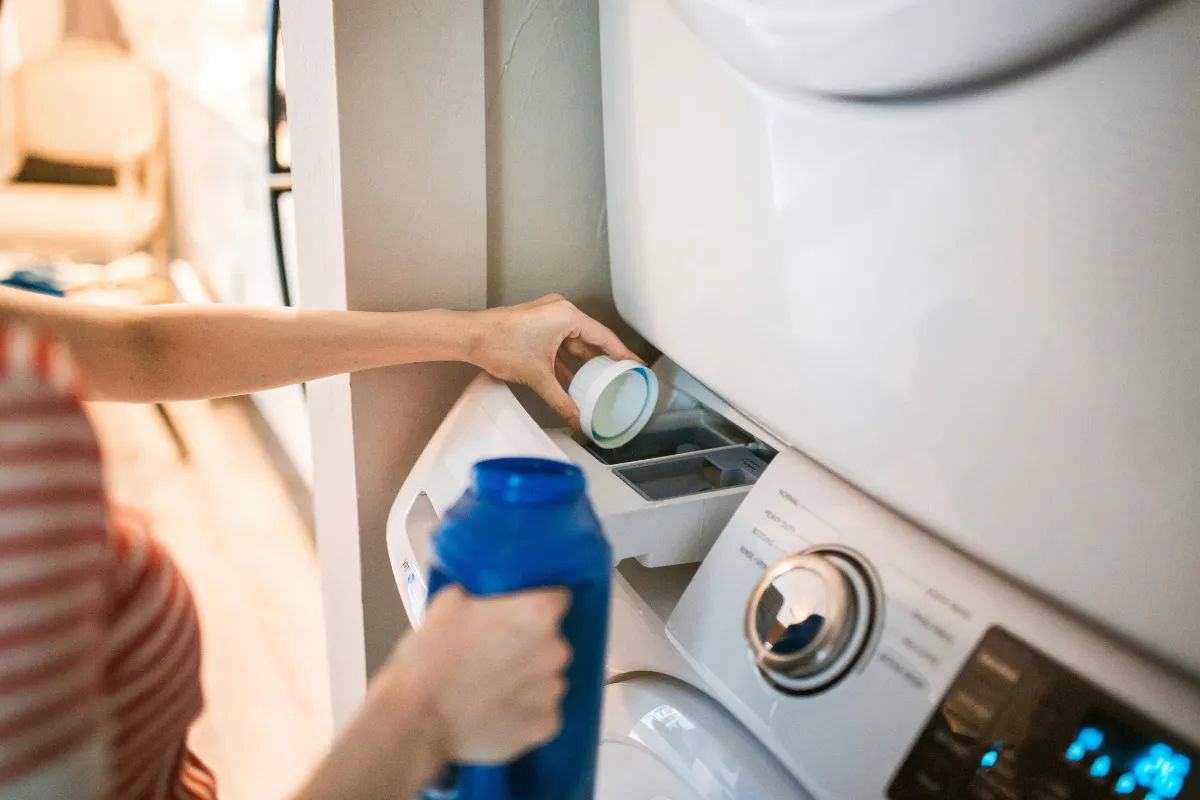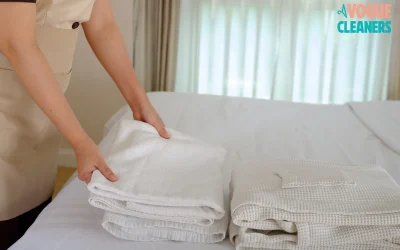Using too much laundry detergent can cause more harm than good. Some common side effects include stiff fabrics, sticky residue, and musty-smelling washers. Instead of getting clothes cleaner, excess detergent can leave behind buildup that traps dirt and bacteria.
Let’s talk about how to tell if you’re using too much, how much detergent you actually need, and how to adjust based on your washer type, water hardness, and load size.
4 Signs You’re Using Too Much Laundry Detergent
It’s easy to use too much detergent, especially with oversized measuring caps. If your laundry isn’t feeling fresh, here are some signs you might be overdoing it:
1. Residue Left on Clothes
White spots, streaks, or blue-green stains on your clothes are a big clue. Dark clothes might come out with visible powdery marks, and light-colored clothes can look dull or feel sticky. This happens when detergent doesn’t fully rinse out.
That leftover soap sticks to the fabric and traps dirt, which can make your clothes feel dirty even though they’re clean.
2. Clothes Feel Stiff and Scratchy
If your clothes don’t feel soft anymore, it could be from leftover detergent. Towels that used to be fluffy might feel rough.
Shirts and socks might feel stiff instead of smooth. This happens when the extra soap stays in the fabric and hardens as it dries, especially in cotton and thick materials.
3. Dull Colors and Graying Whites
When too much detergent builds up over time, it can coat your clothes with a thin film. This makes bright colors look faded and whites turn gray. Instead of coming out fresh and clean, your laundry might look tired and worn, even after just a few washes.
4. Your Washer Has a Musty Odor
That weird smell coming from your washer? It could be detergent buildup inside the drum or rubber seals.
When too much soap sticks around, it holds onto water and creates the perfect spot for mold and bacteria. That musty smell can transfer to your clean laundry too, which isn’t what you want after doing a load of was
How Much Detergent Should You Use?

The amount of detergent you need depends on several factors, including your washer type, load size, and detergent concentration. Here’s a general guideline:
For High-Efficiency (HE) Washers
High-efficiency washers use less water, which means detergent isn’t diluted as much as in standard washers. Using too much can lead to excessive suds that are hard to rinse out.
- Small load: 1 teaspoon
- Medium load: 2 teaspoons
- Large load: 3 teaspoons
For highly concentrated detergents (4X or 10X formulas), use even less—about ¼ to ½ of the recommended amount.
For Standard Top-Load Washers
Traditional washers use more water, so they can handle a bit more detergent, but not as much as most people think.
- Small load: 1 tablespoon
- Medium load: 1.5 tablespoons
- Large load: 2 tablespoons
If using powdered detergent, add it directly to the drum before loading clothes to help it dissolve properly.
Factors That Affect How Much Detergent You Need
Not every load of laundry needs the same amount of detergent. It depends on things like how dirty your clothes are, how big the load is, and what kind of water and washer you have. Here’s how to adjust your detergent to match your laund
1. Water Hardness
The type of water you have at home changes how your detergent works. Soft water makes a lot of suds, so you don’t need much soap.
Using too much in soft water can lead to extra bubbles that are hard to rinse out. If your water is hard, it has minerals in it that make it harder for detergent to clean. In that case, you might need a little more soap to get the job done.
2. Load Size
How many clothes you’re washing matters. A small load doesn’t need much detergent—about half the normal amount is enough. If you’re doing a big load, don’t just dump in more detergent.
What really helps is giving your clothes space to move so the water can rinse them properly. Too many clothes packed in the washer won’t get clean, no matter how much soap you use.
4. Soil Level
Not all dirty clothes are the same. If your clothes are only a little dirty, using too much detergent won’t help.
For really stained or muddy items, it’s better to treat those spots before washing instead of adding extra soap to the whole load. This helps remove stains without wasting detergent or making other clothes feel stiff.
How to Fix Detergent Buildup on Clothes
If you suspect you’ve been using too much detergent, here’s how to remove buildup and get your clothes feeling fresh again:
Vinegar Rinse Method
Soak clothes in a mixture of one part white vinegar to one part water for 30 minutes before rewashing them with no detergent. The vinegar helps break down detergent residue and leaves fabrics softer.
Extra Rinse Cycle
Run an extra rinse cycle with just water to remove any leftover detergent. This is especially useful for high-efficiency washers.
Final Thoughts
More detergent doesn’t mean cleaner clothes. In fact, using too much can cause buildup, stiff fabrics, and a smelly washer. By using the right amount of detergent for your washer type, water hardness, and load size, you’ll get cleaner clothes and a fresher-smelling laundry room.
If laundry still feels overwhelming, Vogue Cleaners in Sacramento offers professional cleaning services to keep your clothes fresh and residue-free!
Schedule a pickup or sign up for Vogue Valet today!






